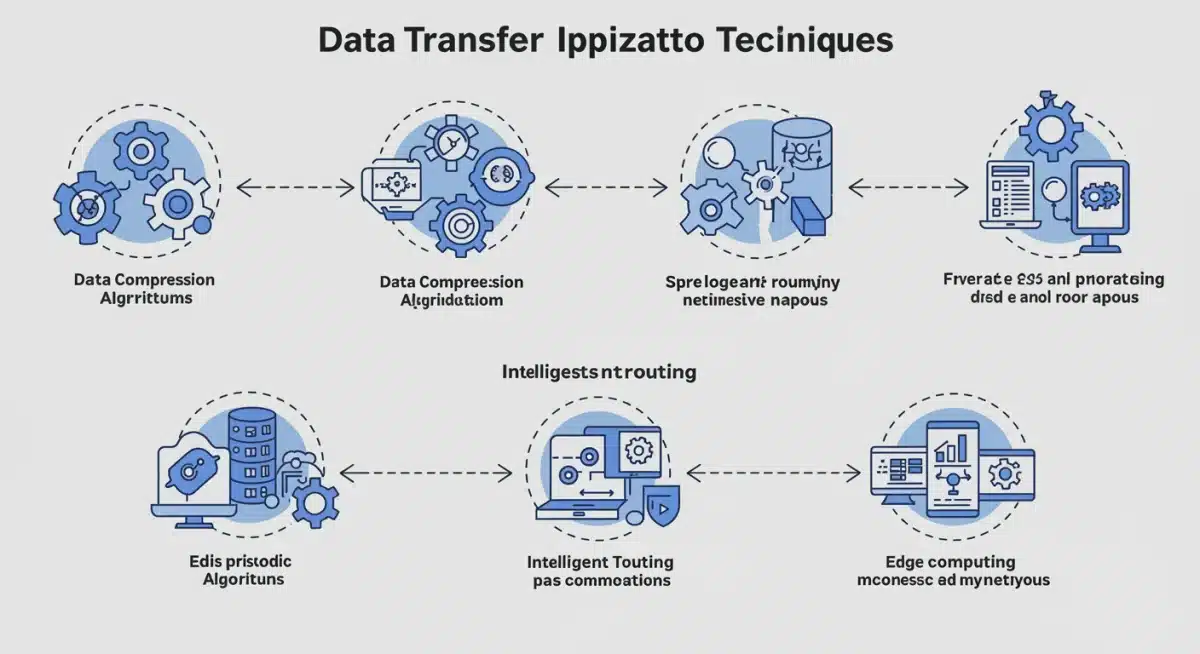Reducing International Data Transfer Costs by 15% in 2025: Strategies for US Enterprises

US enterprises are strategically targeting a 15% reduction in international data transfer costs by 2025, leveraging advanced technologies and optimized global network infrastructures to achieve significant financial savings.
As of late 2024, US enterprises are intensifying efforts towards reducing international data transfer costs by 15% in 2025: Strategies for US Enterprises (FINANCIAL IMPACT), a critical objective impacting global operations and competitiveness. This aggressive target reflects a proactive stance against rising data expenses, driven by accelerated digital transformation and burgeoning cross-border data flows. Companies are now implementing multifaceted strategies, from technological upgrades to policy adjustments, to achieve this ambitious financial goal.
The Mandate for Cost Reduction in Global Data Flows
The push to significantly cut international data transfer costs is not merely a financial aspiration but a strategic imperative. Enterprises operating globally face escalating expenditures due to increased data volumes, complex regulatory landscapes, and the inherent costs of cross-border infrastructure. The 15% target for 2025 signals a concerted effort to optimize these critical operational expenses.
This mandate is emerging from various sectors, including finance, technology, and manufacturing, all heavily reliant on seamless and cost-effective international data exchange. Recent analyses indicate that data transfer costs can represent a substantial portion of IT budgets, making their reduction a high-priority item for Chief Financial Officers and Chief Information Officers alike. The drive for efficiency is coupled with a need for enhanced security and compliance, creating a complex challenge that requires innovative solutions.
Leveraging Cloud Optimization and Hybrid Architectures
Cloud services have long been a double-edged sword for international data transfers, offering scalability but often incurring significant egress fees. However, new strategies in cloud optimization and hybrid architectures are proving pivotal in the quest to reduce costs. Enterprises are now meticulously analyzing their cloud consumption patterns, identifying data residency requirements, and strategically deploying workloads.
Cloud Egress Fee Mitigation
Mitigating cloud egress fees, which are charges for data moving out of a cloud provider’s network, is a primary focus. Companies are adopting multi-cloud strategies and carefully selecting regions to minimize inter-region data movement. Furthermore, the use of content delivery networks (CDNs) is expanding to cache frequently accessed data closer to end-users, drastically reducing the need for repeated international transfers from central cloud repositories.
- Data Residency Planning: Strategically storing data in regions closer to its primary users to reduce cross-border transfers.
- CDN Implementation: Utilizing CDNs to cache content locally and decrease egress from core data centers.
- Hybrid Cloud Deployment: Balancing on-premises and public cloud resources to keep sensitive or high-volume data closer to its processing origin.
- Vendor Negotiation: Actively negotiating with cloud providers for better rates on data transfer services, especially for high-volume users.
Advanced Network Optimization Techniques
Beyond cloud strategies, fundamental improvements in network infrastructure and optimization techniques are crucial. Enterprises are investing in technologies that make data transfer more efficient, secure, and less expensive. This includes everything from advanced compression algorithms to software-defined wide area networks (SD-WAN).
SD-WAN, in particular, is revolutionizing how international data is routed. By intelligently directing traffic over the most efficient and cost-effective paths, often leveraging public internet for non-critical data and private links for sensitive information, SD-WAN solutions are cutting reliance on expensive MPLS (Multiprotocol Label Switching) circuits. This flexibility allows for dynamic adjustment to network conditions and cost structures, providing significant savings.

Data Compression and Deduplication
Before data even leaves the local network, techniques like data compression and deduplication are applied to reduce the overall volume of data being transferred. This directly translates to lower bandwidth usage and, consequently, reduced costs for international links. Modern compression algorithms can achieve significant reductions without compromising data integrity or transfer speed.
- WAN Optimization Appliances: Deploying hardware or software solutions at network edges to optimize traffic.
- Protocol Optimization: Fine-tuning network protocols to improve efficiency over long-distance links.
- Traffic Shaping: Prioritizing critical data and de-prioritizing less urgent traffic to manage bandwidth effectively.
Navigating Regulatory and Compliance Complexities
The global regulatory landscape for data transfer is constantly evolving, with new privacy laws and data residency requirements emerging regularly. Compliance with these regulations can inadvertently increase costs, but strategic navigation can also present opportunities for optimization. Understanding and proactively addressing these complexities is vital for US enterprises.
For instance, adherence to regulations like GDPR in Europe or various data localization laws in other countries often dictates where data must be stored and processed. This can influence decisions on data center locations, cloud regions, and the very architecture of international data flows. Enterprises are investing in legal counsel and compliance technologies to ensure they meet these requirements without incurring unnecessary transfer costs.
Impact of Data Localization Laws
Data localization laws, which require certain types of data to be stored and processed within a country’s borders, directly affect international data transfer strategies. While they can restrict free data flow, they also force enterprises to establish localized infrastructure, which can paradoxically reduce long-haul transfer costs for local operations. The key is to balance global operational needs with local compliance requirements.
- Localized Data Storage: Establishing regional data centers or cloud instances to comply with local laws and reduce intercontinental transfers.
- Legal and Compliance Audits: Regularly reviewing data transfer practices against evolving international regulations.
- Privacy-Enhancing Technologies: Utilizing anonymization and pseudonymization to reduce the sensitivity of data transferred internationally.
Emerging Technologies: Edge Computing and 5G
The advent of edge computing and the widespread rollout of 5G networks are poised to significantly impact international data transfer costs. These technologies bring computation and data storage closer to the source of data generation, reducing the need to send raw data over long distances to central processing units or cloud data centers.
Edge computing allows for immediate processing of data at the ‘edge’ of the network, meaning only processed insights or aggregated data need to be transferred internationally. This dramatically cuts down on the volume of data traversing expensive global links. Similarly, 5G’s low latency and high bandwidth capabilities are enabling more efficient local processing and faster, more economical transfers when international movement is unavoidable.
Real-time Data Processing at the Edge
Industries such as manufacturing, IoT, and autonomous vehicles are particularly benefiting from edge computing. Sensor data, for example, can be analyzed locally, with only critical alerts or summaries sent back to headquarters, bypassing costly international routes for raw, high-volume data streams. This shift is fundamental to achieving the 15% cost reduction target.
- Decentralized Data Processing: Moving data analytics closer to the source of data generation.
- Optimized IoT Deployments: Leveraging edge devices to filter and process IoT data locally before transmission.
- 5G for Local Connectivity: Utilizing high-speed 5G networks for efficient local data aggregation and initial processing.
Strategic Vendor Management and Negotiation
A critical, often overlooked, aspect of cost reduction is strategic vendor management and negotiation. Many enterprises are locked into long-term contracts with telecommunications providers, cloud vendors, and data center operators that may not reflect current market rates or their evolving data transfer needs. Proactive vendor engagement can unlock significant savings.
This involves regularly reviewing service level agreements (SLAs), benchmarking current costs against market averages, and consolidating services where possible. Leveraging buying power and fostering competitive bidding among vendors can lead to more favorable terms for international data transfer services.
Contract Renegotiation and Consolidation
Enterprises are increasingly engaging in regular contract renegotiation cycles, often every 12-24 months, to ensure their agreements are optimized. Consolidating multiple smaller contracts into a larger, single agreement with a preferred vendor can also yield volume discounts and better service terms, directly contributing to the 15% cost reduction goal.
- Regular Contract Reviews: Annually assessing existing contracts for opportunities to reduce costs or improve terms.
- Benchmarking Services: Comparing current vendor costs against industry benchmarks to identify areas for negotiation.
- Consolidated Procurement: Streamlining vendor relationships to gain leverage in pricing discussions.
Internal Policy and Data Governance Reforms
Finally, achieving a 15% reduction in international data transfer costs requires not just technological upgrades but also significant internal policy and data governance reforms. This involves educating employees, implementing stricter data retention policies, and fostering a culture of cost-consciousness regarding data usage.
Unnecessary data transfers, duplicate data storage, and inefficient data lifecycle management can all contribute to inflated costs. By establishing clear guidelines for data handling, storage, and transfer, enterprises can prevent wasteful practices and ensure that data is only moved internationally when absolutely necessary and through the most efficient channels.
Employee Training and Awareness
Training employees on the financial implications of data transfer and promoting best practices for data management are vital. Simple changes, like encouraging the use of shared drives over individual transfers or optimizing file sizes, can collectively lead to substantial savings across a large organization. Data governance frameworks are being updated to reflect these new priorities.
- Data Minimization Principles: Adopting policies to collect and transfer only the data that is strictly necessary.
- Automated Data Lifecycle Management: Implementing tools to automatically archive or delete old data, reducing storage and transfer needs.
- Internal Cost Allocation: Introducing chargeback models to make internal departments accountable for their data transfer costs.
| Key Strategy | Brief Description |
|---|---|
| Cloud Optimization | Minimizing egress fees and optimizing data residency across cloud providers. |
| Network Enhancements | Implementing SD-WAN, compression, and deduplication for efficient data routing. |
| Edge & 5G Adoption | Processing data closer to source, reducing long-haul transfers with new technologies. |
| Vendor Negotiation | Proactive engagement with providers to secure better rates and contract terms. |
Frequently Asked Questions About Data Transfer Cost Reduction
Increased digital transformation, larger data volumes, and complex global regulations have escalated cross-border data expenses. Reducing these costs by 15% is a strategic financial imperative to maintain competitiveness and operational efficiency in a globalized market.
Cloud egress fees are charges for moving data out of a cloud provider’s network. These fees can significantly inflate international transfer costs, especially for enterprises with distributed operations requiring frequent data access across different cloud regions or returning data to on-premises systems.
SD-WAN optimizes data routing over cost-effective paths, reducing reliance on expensive private links. Edge computing processes data closer to its source, minimizing the volume of raw data needing to be transferred internationally, both contributing significantly to cost savings.
While compliance with data residency and privacy laws can introduce costs, strategic planning can mitigate this. Localizing data storage or leveraging privacy-enhancing technologies can sometimes reduce long-haul international transfers, balancing compliance with cost-efficiency.
Proactive vendor negotiation ensures enterprises secure favorable terms for data transfer services. Regularly reviewing contracts, benchmarking against market rates, and consolidating services can lead to significant cost reductions and improved service level agreements (SLAs).
Impact and Implications
The aggressive target of reducing international data transfer costs by 15% in 2025 for US enterprises signals a profound shift in global operational strategies. This isn’t merely about cutting expenses; it’s about reshaping how businesses interact with data on a worldwide scale. The successful implementation of these strategies will not only bolster financial health but also enhance agility, improve regulatory compliance, and foster innovation through more efficient data utilization. As the digital economy continues its rapid expansion, the ability to manage and move data cost-effectively will be a defining factor in competitive advantage, setting a new benchmark for global interconnectivity and operational excellence.





